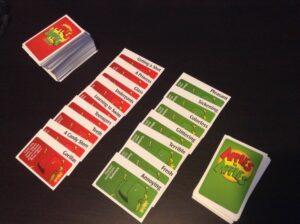Apples to Apples, designed by Matthew Kirby and Mark Alan Osterhaus and published by Mattel, is a card-based party game designed for 4 to 10 players and intended for ages 12+. It heavily relies on a judging system which creates a dynamic social metagame that rewards emotional intelligence and cleverness, resulting in an aesthetic experience that prioritizes fellowship as well as competition. However, it’s crucial to recognize that this same mechanic can also lead to potential issues of perceived favoritism and players suppressing their creativity to cater to the judge’s tastes.
At the core of Apples to Apples’ gameplay is its judging mechanic. Each round, one player assumes the role of the judge and draws a green apple card featuring an adjective like “Courageous” or “Ridiculous.” The other players must then select a red apple card from their hand that they believe best matches the green card’s adjective and submit it face-down to the judge. The judge shuffles the submissions, reads them aloud, and chooses a winner based on their personal preference.
This rotating judge role creates a fascinating social metagame that goes beyond just matching cards. Players must consider the judge’s personality, sense of humor, and background when deciding which card to play. In the most recent game I played, the green apple card was “Magical,” and I knew the judge was a fan of fantasy literature. I strategically played the “Harry Potter” card, appealing to their interests and winning the round.

As shown in the image, there are a variety of cards that both the judge and the other players can select. For example, if a certain player chose “Learning to Swim” for “Terrible” whereas another player chose “Getting a shot,” although both choices could be interpreted as terrible, the former may resonate with a judge who struggled learning how to swim. Therefore, Apples to Apples’ judging mechanic specifically rewards players who can effectively read the room and tailor their card choices to the judge’s tastes. By encouraging players to consider each other’s perspectives and backgrounds, the game fosters a sense of empathy and social awareness that enhances the aesthetic of fellowship.
Moreover, the judging mechanic creates opportunities for players to showcase their creativity and humor. When a player submits an unexpected or clever card combination, it often leads to various reactions and lively discussion among the group. For example, in one round, a player submitted “The DMV” for the adjective “Fun,” which led to an entire discussion about how everyone had bad experiences during their first driving test. This moment demonstrates how the judging mechanic encourages players to think outside of the box—potentially creating entertaining juxtapositions—which in turn strengthens the bonds between players through shared amusement.
However, it’s also important to acknowledge the possible drawbacks of the judging mechanic in the specific context of Apples to Apples. The subjective nature of the judge’s decision can sometimes lead to feelings of favoritism or unfairness. In one game session, a player who was not well known in our group became somewhat frustrated that their cards were repeatedly not chosen and that led them to disengage from the game. When I asked them about why they had stopped playing, they mentioned that the game became “boring and pointless” when they noticed that the judge focused on their friends’ cards over others’ cards. This example highlights the importance of ensuring that all players feel their contributions are valued and considered. To mitigate this issue, the game could introduce a mechanic where there is a panel of two to three judges all deciding on which choice is the best fit to their selected adjective card. As a result, collaboration is even further emphasized as the group of judges have each other to share ideas and come up with a rationale for their ultimate choice.
Furthermore, the desire to win over the judge can occasionally stifle players’ creativity and self-expression. Instead of playing the cards they genuinely believe are the best fit, players may feel pressured to cater to the judge’s perceived preferences. This can lead to a homogenization of card choices and a dampening of the game’s potential for humor and originality. In a specific round, there was an interesting outcome where the green apple card was “Charming,” and the judge was a relatively well-read person who liked classic literature. All of the players chose cards related to famous romantic figures like “Romeo,” hoping to appeal to this judge’s literary tastes. Unfortunately, this meant that all of the cards selected were similar to each other and generated less dialogue between the players due to the lack of a surprising reveal. This impacts the game’s dynamic of creative expression and slightly diminishes the fun for those—like myself—who enjoy a variety of different red apple words clashing with each other. To address this issue, I came up with a variant of Apples to Apples that included a “Fan-Favorite” mechanic. In this version, players could vote for their favorite card in addition to the judge’s selection, with the “Fan-Favorite” card earning bonus points. We found that this mechanic reinforced the dynamic of allowing players to have a choice between leveraging the judge’s sense of humor or their own, resulting in more creative word selections.



